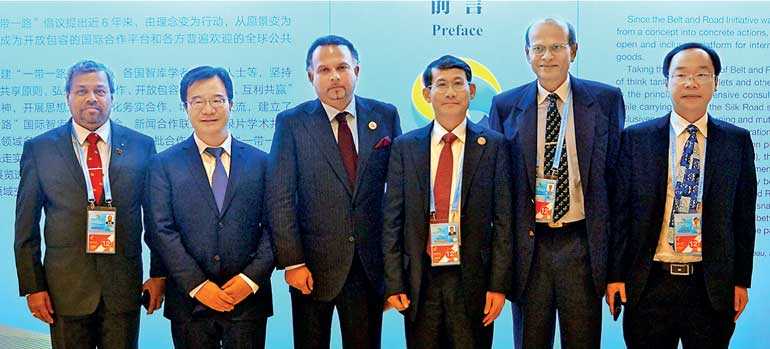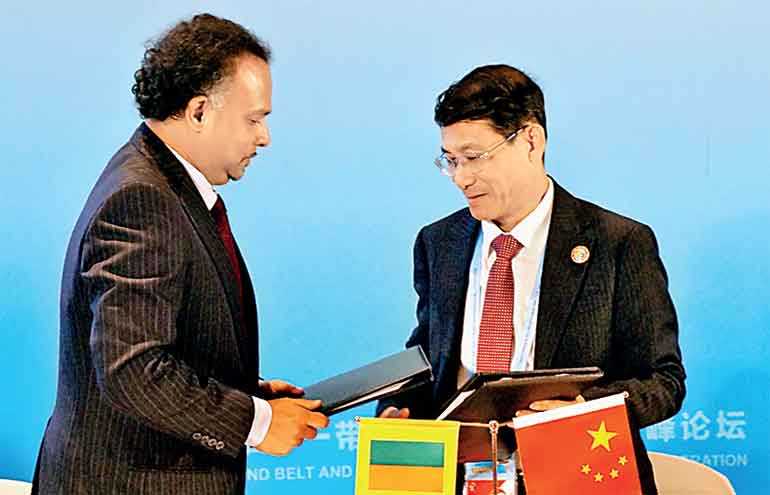Friday Apr 18, 2025
Friday Apr 18, 2025
Monday, 6 May 2019 00:00 - - {{hitsCtrl.values.hits}}


Plantation Industries Minister Navin Dissanayake inked a historic MOU in Beijing on 25 April at the Second Belt and Road Forum for International Cooperation held at the China National Convention Centre, an event attended by Chinese President Xi Jinping and over 37 national leaders and thousands of international participants including ministers and corporate executives from all over the world.
The MOU signed by Navin Dissanayake and People’s Government of Hainan Province Executive Governor Dr. SHEN Danyang during the Thematic Forum on Sub-national Cooperation aims at rejuvenating the Sri Lanka’s ailing plantation sector that comprises of tree crops including rubber, tea, coconut, cashew, sugar cane as well as related industrial value chains.
During the Stage I of the intervention, Sri Lankan rubber industry would be the main focus, taking the famous Rubber-Rice Pact (RRP) (1952) as the point of departure. While the RRP lasted for 30 years with diminishing value in later years, it is predicted that the new agreement, an integral project of the Belt and Road Initiative will provide immense benefits to both countries in terms of enhanced socioeconomic benefits and increased international trade for numerous decades to come.
The vision of the leaders who signed the agreement is the creation of a unique Regional Rubber Corridor using Sri Lanka as the nexus between Hainan rubber industry, Sri Lankan rubber industry cluster and global markets. By complementing the distinctive competitive advantages and unique resources of the two countries, backed by strong policy commitment expressed by both countries, a sustainable plantation-industrial-international trade value platform will be created through implementing a number of programs and projects in the future.
The projects are to be designed based on the Sri Lanka Rubber Industry Development Master Plan which is a 10-year growth plan aimed at earning $ 4-5 billion from the rubber industry. Beginning June, China will field competent teams to conduct project feasibility studies across the industry value chains with the participation of Sri Lankan private sector and government resource persons.
Many leaders present at the forum congratulated the Sri Lankan Minister for his succinct speech delivered eloquently stressing the fact that Sri Lanka will unitedly, bravely and speedily overcome the effects of recent tragic events bringing normalcy and facilitating revival of tourism and investments.
He also expressed his determination to use this agreement to take the Sri Lankan rubber industry to new heights. All other speakers assured the fullest support for Sri Lanka to overcome the growing menace of global terrorism while condoling deeply with Sri Lanka citizens.
In implementing the MOU, Sri Lankan rubber industry will work closely with the Hainan Rubber Industry Group (HRIG), a listed company with market capitalisation of over $ 4.2 billion. HRIG is a subsidiary of Hainan State Farms Ltd., which manages over one million hectares.
Before signing the MOU, in early April, HRIG Chairman Dr. Wang Renfie visited Sri Lanka with a delegation of experts to satisfy himself on the potential for collaboration and investment. In this connection, since July 2018, at least seven Chinese delegations visited Sri Lanka to study the status of the plantation sector and value adding industries to examine the development potential that can be leveraged to capture international markets.
Inaugurated as a province in 1988, Hainan is a beautiful green island of 35,400 sqkm with 9.4 million people, which is receiving special attention of President Xi Jinping who first declared the whole island as a Special Economic Zone and a pilot Free Trade Zone.
In 2018, President Xi announced that Hainan Province will be a Free Trade Port with Chinese characteristics. The island has a network of five ports serving four directions which are Haikou, Sanya, Qinglan, Yangpu and Basuo in addition to three airports. In other words, Hainan will be the most crucial pivot of the 21st Century Maritime Silk Road and become the modern gateway to the Western World.
Many analysts believe that the new MOU signed 67 years after inking the first China Ceylon trade agreement, will herald a new era in bilateral relations between China and Sri Lanka. Sri Lanka’s plantation sector badly needs investments of long-term nature, adoption of advanced cutting edge technologies, competitive and bold management thinking, exceptionally sound business strategies and access to emerging lucrative markets.
Sri Lanka must upgrade its outdated technological infrastructure both soft and hard, modernise its human capital in work ethics and competencies and also adopt new breakthrough management models to serve the global markets emerging with seamless disruptive effects. In filling these gaps, China is ready to partner with Sri Lanka in win-win collaboration based on mutual trust.
The Sri Lankan Minister also had the opportunity to meet People’s Republic of China Agriculture and Rural Affairs Vice Minister Yu Kangzhen at his office. The discussion was centred on strengthening the bilateral cooperation in the development of plantation agriculture and technology transfer which include exchange of experts in relation to collaboration in R&D.
The bold initiative taken by Dissanayake with the support of the Chinese Government must be appreciated and supported by all Sri Lankans concerned about the future of Sri Lanka’s resource-based industrial sectors which collectively sustain over a million people vulnerable to vagaries in commodity markets and other economic shocks.
Viability of the plantation sector depends primarily on the prosperity and resilience of its people. The MOU, when implemented effectively, no doubt would contribute significantly to the achievement of this goal.
Discover Kapruka, the leading online shopping platform in Sri Lanka, where you can conveniently send Gifts and Flowers to your loved ones for any event including Valentine ’s Day. Explore a wide range of popular Shopping Categories on Kapruka, including Toys, Groceries, Electronics, Birthday Cakes, Fruits, Chocolates, Flower Bouquets, Clothing, Watches, Lingerie, Gift Sets and Jewellery. Also if you’re interested in selling with Kapruka, Partner Central by Kapruka is the best solution to start with. Moreover, through Kapruka Global Shop, you can also enjoy the convenience of purchasing products from renowned platforms like Amazon and eBay and have them delivered to Sri Lanka.
Discover Kapruka, the leading online shopping platform in Sri Lanka, where you can conveniently send Gifts and Flowers to your loved ones for any event including Valentine ’s Day. Explore a wide range of popular Shopping Categories on Kapruka, including Toys, Groceries, Electronics, Birthday Cakes, Fruits, Chocolates, Flower Bouquets, Clothing, Watches, Lingerie, Gift Sets and Jewellery. Also if you’re interested in selling with Kapruka, Partner Central by Kapruka is the best solution to start with. Moreover, through Kapruka Global Shop, you can also enjoy the convenience of purchasing products from renowned platforms like Amazon and eBay and have them delivered to Sri Lanka.